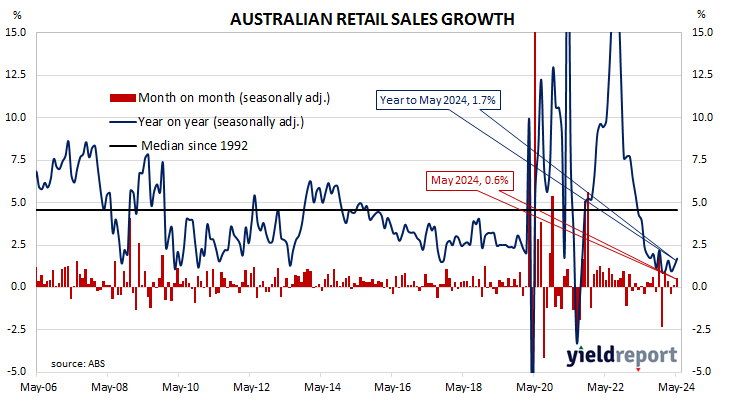Summary: Retail sales up 0.6% in May, noticeably more than expected; up 1.7% on 12-month basis; ANZ: seasonal factors at play, end-of-financial year sales ramping up earlier; ACGB yields rise modestly; rate-rise expectations firm; Westpac strong population growth cushioning hit to retailers; largest influence on result from food sales.
Growth figures of domestic retail sales spent most of the 2010s at levels below the post-1992 average. While economic conditions had been generally favourable, wage growth and inflation rates were low. Expenditures on goods then jumped in the early stages of 2020 as government restrictions severely altered households’ spending habits. Households mostly reverted to their usual patterns as restrictions eased in the latter part of 2020 and throughout 2021.
According to the latest ABS figures, total retail sales rose by 0.6% on a seasonally adjusted basis in May. The rise was noticeably more than the 0.3% increase which had been generally expected as well as April’s 0.1% increase. Sales increased by 1.7% on an annual basis, up from 1.2% after revisions.
“On face value it looks like a strong print, but there could be some seasonal factors at play with end-of-financial year sales ramping up earlier this year,” said ANZ economist Madeline Dunk.
The update was released on the same day as the latest dwelling approval figures and Commonwealth Government bond yields moved modestly higher on the day, in contrast with the falls of US yields on Tuesday night. By the close of business, 3-year, 10-year and 20-year ACGB yields had all added 2bps to 4.13%, 4.44% and 4.76% respectively.
Expectations regarding rate rises in the next twelve months firmed slightly by the end of the day. In the cash futures market, contracts implied the cash rate has some chance of rising above the current rate of 4.32% in the short-term, with an average of 4.40% in August and 4.47% in November. February 2025 contracts implied 4.455% while May 2025 contracts implied 4.37%, 5bps above the current cash rate.
“All up, despite a slightly better tone, the May retail results still point to a consumer under intense pressure, strong population growth doing a lot to cushion the hit to retailers,” said Westpac senior economist Matthew Hassan. “The July tax cuts should see some reprieve as we move into the second half of the year, although exactly how much rests heavily on how much of this consumers choose to save rather than spend.”
Retail sales are typically segmented into six categories (see below), with the “Food” segment accounting for 40% of total sales. Accordingly, the largest influence on the month’s total came from this segment where sales rose by 0.7%.



